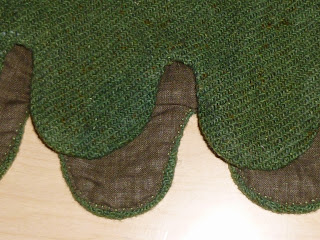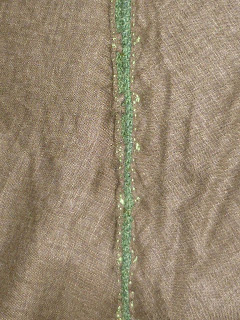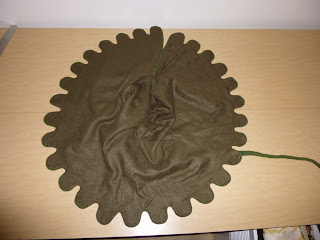I am in the process of re-finishing a chair.
I actually haven't worked on it for several weeks because the weather has been so cold and wet. It's nice weather to go walking in, but not nice for sitting outside and sanding furniture, so the chair remains only partially sanded.
The chair isn't the point of this post though. The lower part of the chair has a little shelf on it. The shelf originally had 4 wide wooden slats, but, by the time I came into possession of it one of the middle slats was broken, the other missing entirely.
This was the broken slat.
For a few days I wasn't sure what to do with it. There wasn't much sense leaving it on the chair, but it was such a nice piece of hardwood that I didn't want to burn it.
Then I realized that it was perfect for a busk! It was almost exactly the right size and shape already. I had been planning to make a pair of earlier 18th century stays, so having a busk would be great.
 |
| The broken slat, marked for sawing. |
I sawed off the wide end and the corners of the narrow end. Later, upon discovering that it was too long, I sawed a bit more off the wide end.
I looked at a lot of extant busks, mostly
from the Met, and found an enormous variety in shape. They ranged from thin, round sticks to giant tongue depressors.
I made mine medium sized and somewhat tapered.
 |
| It required very little chiseling. |
After cutting it down to the right size and shape I sanded it. (By hand. Palm sanders are wonderfully fast but terribly inaccurate.)
 |
| All sanded. |
I suppose I could have left it like this, but I don't really like the tan colour of unfinished wood.
Fortunately, I happened to have a bottle of stain that I made a few years ago.
I made it using walnuts. The instructions for making walnut stain say to use black walnuts, but I've never seen any black walnut trees. I don't think they grow in New Brunswick. We do have plenty of white walnuts though. I got a bunch of them from a tree at my Grandfather's farm while they were still green.
I put these green walnuts into a large can, poured boiling water over them, and let them sit for three days. I then removed the walnuts, strained the resulting dark brown liquid, and brought it to a boil to kill any microbes that may have taken up residence there.
I put it into a bottle and added some vinegar to keep it from going bad. I found these directions on the internet, but I can't remember where.
I'm not sure if this stain is historically accurate or not, but being made from local ingredients by a very simple method I think it's entirely plausible.
 |
| The stain appears to be running low. I must obtain more walnuts. |
I brushed the stain on in thin coats, letting it dry for about an hour between applications.
After 4 coats it was a very nice dark brown.
 |
| The busk after being stained. |
It still needed to be sealed with something as the stain was not entirely fast.
My original plan was to use shellac, but the shellac that my father had was quite old and wouldn't dry. I decided to use tung oil instead. The Chinese have been using tung oil as a wood finish for thousands of years, but it didn't arrive in North America until the 20th century. This makes it completely inaccurate for my location, but still historical.
Here is the busk after two coats of tung oil.
It looks kind of dark in that light. Here is a picture taken without a flash.
Somewhat Altered Summary of Facts
The Challenge: #19- Wood, Metal, Bone.
Materials: One broken hardwood chair slat, walnut husk infusion, tung oil.
Dimensions: 36cm x 4cm x 7mm.
Year: A very large chunk of time. I'm not quite sure exactly how big the window is, but it is definitely good for most of the 18th century, up until about the 1780s. There are portions of the 17th century for which it would also work.
How historically accurate is it? The look is most likely accurate. The wood is pretty old and I don't see how it could possibly be inaccurate. The stain is plausible. The tung oil is inaccurate for my location, though it did exist at the time. Shellac would have been much more accurate. The making situation is completely inaccurate, a lady would most certainly not have carved her own busk.
Hours to complete: 4 hours, 20 minutes.
First worn: Not yet, I still need to make stays to go with it.
Total cost: $0
I suppose the busk isn't technically finished since I'm going to give it a few more coats of oil over the next couple of weeks, but it is still waterproofed and usable in it's current state.
I am still working on the pattern for the stays.
So far the only extant stays I've found that have a busk pocket are
the orange ones from the KCI.
 |
| Stays, early 18th century, Kyoto Costume Institute. The pocket in the front is clearly visible. |
These stays look nothing like the ones I'm making though, so I'll probably just ignore them. Mine are going to be
front lacing, with a large stomacher panel. I'm not sure if it's accurate to put busk pockets in those stomacher things, but I'm doing it anyway.
Does anyone know of any other extant stays with busk pockets?























































